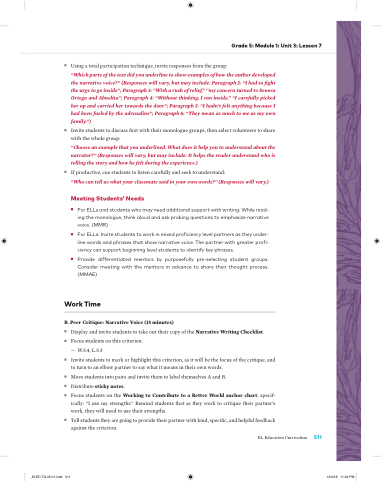Page 535 - EL Grade 5 Teacher Guide
P. 535
Grade 5: Module 1: Unit 3: Lesson 7
■ Using a total participation technique, invite responses from the group:
“Which parts of the text did you underline to show examples of how the author developed the narrative voice?” (Responses will vary, but may include: Paragraph 2: “I had to ght the urge to go inside”; Paragraph 3: “With a rush of relief,” “my concern turned to Senora Ortega and Abuelita”; Paragraph 4: “Without thinking, I ran inside,” “I carefully picked her up and carried her towards the door”; Paragraph 5: “I hadn’t felt anything because I had been fueled by the adrenaline”; Paragraph 6: “They mean as much to me as my own family.”)
■ Invite students to discuss rst with their monologue groups, then select volunteers to share with the whole group:
“Choose an example that you underlined. What does it help you to understand about the narrator?” (Responses will vary, but may include: It helps the reader understand who is telling the story and how he felt during the experience.)
■ If productive, cue students to listen carefully and seek to understand:
“Who can tell us what your classmate said in your own words?” (Responses will vary.)
Meeting Students’ Needs
■ For ELLs and udents who may need additional support with writing: While read- ing the monologue, think aloud and ask probing que ions to emphasize narrative voice. (MMR)
■ For ELLs: Invite udents to work in mixed pro ciency level partners as they under- line words and phrases that show narrative voice. The partner with greater pro - ciency can support beginning level udents to identify key phrases.
■ Provide di erentiated mentors by purposefully pre-selecting udent groups. Consider meeting with the mentors in advance to share their thought process. (MMAE)
Work Time
B. Peer Critique: Narrative Voice (15 minutes)
■ Display and invite students to take out their copy of the Narrative Writing Checklist.
■ Focus students on this criterion:
— W.5.4, L.5.3
■ Invite students to mark or highlight this criterion, as it will be the focus of the critique, and to turn to an elbow partner to say what it means in their own words.
■ Move students into pairs and invite them to label themselves A and B.
■ Distribute sticky notes.
■ Focus students on the Working to Contribute to a Better World anchor chart, specif- ically: “I use my strengths.” Remind students that as they work to critique their partner’s work, they will need to use their strengths.
■ Tell students they are going to provide their partner with kind, speci c, and helpful feedback against the criterion.
EL Education Curriculum 511
_ELED.TG.05.01.indb 511
12/4/18 11:49 PM


